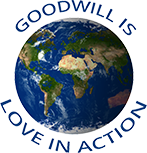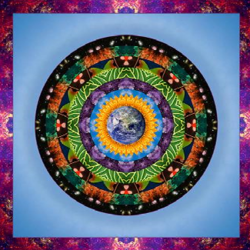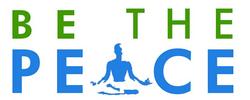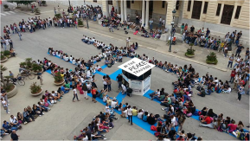WATCH ON YOUTUBE
David Nicol
(Director, Gaiafield Project)
Today’s task is relatively straightforward, for subtle activism is in many ways a name for something that we’re doing here today and that many groups are doing. Part of my work is to create a framework that is large enough so groups can recognize each other and bring more coherence to that field. Sometimes people say we have to do more than preach to the choir but part of our work is helping the choir to find each other, and there is a very beautiful song to be sung on this planet when we all connect our streams to one another, and the potential of the amplification for what can happen on this Earth is magnificent.
It is a little challenging to talk about this concept of subtle activism in a public setting, it’s truly a subtle and mysterious process and the kind
of power we’re talking about only happens when we are totally transparent and open. In some ways it is an unusual phenomenon to be leaning in with our awareness to things that are happening in the world but to be totally undefended. But when we do, we are meeting the world with our truth and that is what we are really talking about. Sometimes it’s not easy to be transparent when facing the world, but part of our work is to create these spaces where we can give each other permission to open and access our heart’s deepest yearning for what we want to see in the world, as we engage with the issues of the world.
How did I come to this work of subtle activism? In my late teens I had a profound experience, out of the blue, of the impermanence of life. I had the realization that I would die and that anything I had previously thought was meaningful in terms of external achievements and relationships would be gone. It just entered into my mind as a very different thought that totally changed my trajectory and propelled me into a path of spiritual work and discovery that has been the centerpiece of my life since then. But paralleling this interest in spirituality, I've always been extremely interested in the political arena and especially by those individuals who would sometimes seem to be seized by a force of destiny to stand up in the public arena for a profound truth—Gandhi and Martin Luther King, Jr. I was fascinated by the force of destiny that seems like it was inherent and profoundly purposeful in their lives. So I've always been looking for ways to bring these two worlds together—this deep personal quest for spiritual realization and the world of social change. And especially as I've become more awake to the collective issues of the pivotal moment that we seem to be in – the difficult trajectory modern civilization is on and wanting to play a role in shifting things on a collective level.
Initially I became interested in activism, environmental activism, and became an environmental lawyer in Australia and went to rallies and participated in legal action and while I found many of these things deeply meaningful there were certain aspects about them that I didn’t find so satisfying. I found in this work that while we wanted to focus on global issues they tended to get blurred by the minutiae at the local level. I was motivated to not just put out fires here and there but was interested in the source that kept feeding those fires. What was the underlying consciousness that kept creating these problems and how could we engage in a way that was targeting that level of consciousness? I was struck by the fact that many of the activists I was involved with were responding in very reactive ways, using an angry, confrontational approach. I found I needed to find a way to engage that was more aligned with my deep spiritual values and experiences. So following that quest of trying to bring things together brought me to the US and the California Institute of Integral Studies and opened me up to the many visionary thinkers there. A series of events happened.
In response to Dennis Kucinich’s presidential campaign in 2004 my co-workers and I developed a Spiritual Call to Action to more explicitly tap the spiritual dimension of the campaign. We emailed people inviting them to engage in a series of global meditations. This experience was a revelation. We engaged people from over sixty countries and had a massive response. The experience gave me a sense as if different streams of meaning were meeting within me. It really resonated deeply within me, activating a sense of purpose. I felt “this makes sense. This is how I want to contribute, this is what I want to do.” That path found me and when it did it became clear this was the way for me and ever since it’s as if the path has been forming.
Subtle activism is defined as spiritual or consciousness-based practices to support collective transformation. It’s a very broad frame to link the various efforts that are moving in the same direction. Subtle activism is a type of engaged spirituality that can lead to wise action in the world but there is a distinction between what I am trying to bring forward and the spiritual practice in and of itself. Subtle activism is a powerful form of action that is often overlooked but, if it can be harnessed, it can be very powerful. My effort is to harness that power within the context of a more integrative approach to social change though it is not a substitute for more physical forms of action, but something we do as a more holistic approach that meets the inner meaning dimension as well as the practical dimension of social change.
For me, the essence of subtle activism is that it targets collective transformation, but it can be engaged in by individuals, small groups or large groups. We can think of subtle activism as addressing different aspects of the collective. We can think of healing collective traumas from the past, e.g., practices that help heal the emotional and spiritual residue of the Holocaust. We can think of it as providing support during natural disasters or socio-political crises in the present. When there is a collective emergency or crisis taking place in a part of the world, like the Japanese tsunami, you see a massive influx of aid on many levels, including prayer and many people feel spontaneously moved for the people who are suffering. What we are proposing is that we harness that impulse and wave of compassion that is flowing around the Earth at such times. And then we can think of actions for the future where thousands of people are holding a vision of the Earth at peace and creating an attractor in the collective psyche that we can move towards.
How is this idea important now, and what is unique about our moment that calls for such an approach? In many ways this is a very natural
phenomena throughout human history. If you go back to ancient and indigenous cultures the shamans and the seers, the wise men, were always deeply involved in the collective decision making of their societies. By many accounts, while they did do individual healing, the thrust of the function of the shaman was to maintain the balance between the human society and the non-human world through the journey, the ceremony, through engaging on subtle levels to keep the balance. So in many ways it is just a natural orientation. In modern times, in the West, we have seen spirituality divorced from the collective decision-making process. One way of understanding what we are living in, the deep structure of modern life, is by understanding the scientific and political revolutions we’ve experienced and the resultant separation of church and state that had the effect of creating these sort of separate worlds in which we operate. We had the world of science that objectively studied nature; we had the world of politics that looked at the world of human relations and then everything else was left within the private domain and subjective experience. This development was obviously very important as we needed to free ourselves from the constraints and dogma of the church. But we then inherited this world where there is a deep assumption that spirituality might be relevant for your personal life but you can’t bring those insights, the fruits of your wisdom, out into the public domain and be taken seriously. Immanuel Kant was once asked, “what’s the essence of modernity?” and he said, “Modernity means if someone is to come into your room and catches you on your knees praying to god, you should be embarrassed.” In the last few decades public modern western consciousness is coming closer to the point of recognising that the trajectory we are on has something fundamentally wrong with it. The signs are everywhere and do not need to be spelled out in the global environmental crisis, the unsustainability of the financial system, weapons of mass destruction—all of these signs that have deeply disillusioned the modern psyche’s faith in the modern path—a recognition dawning that something is fundamentally off track. We need to rethink this notion that there is no legitimate role for spirituality in the public arena. Many people are becoming aware that the disenchanted world view they have come out of – a view that sees no presence of the sacred anywhere in the world – has empowered an irreverent attitude towards nature. It invites a reconsideration of the sense and presence of the sacred. Gaps are needed for the presence to enter. Gaps are very interesting. I see much of our work in subtle activism practices as creating spaces for something to happen and for a knowing to come in.
So we now stand in the role of the great shaman and collective healing needs to happen on Earth. We are the shamans, the world is the tribe and we can engage in these practices that help on very subtle levels to rebalance things. This is a movement towards group meditation and collective wisdom and this is a key point moving forward: the recognition that the group practice is exponentially more powerful than the collection of individuals in that group.
The mission of Gaiafield Project is to create the intellectual, spiritual, technological and social foundation for the long term growth of the emerging field of subtle activism. We want to create a space where many different groups can come together.



